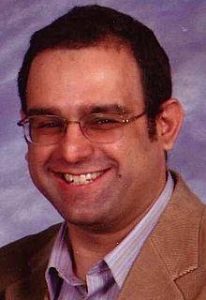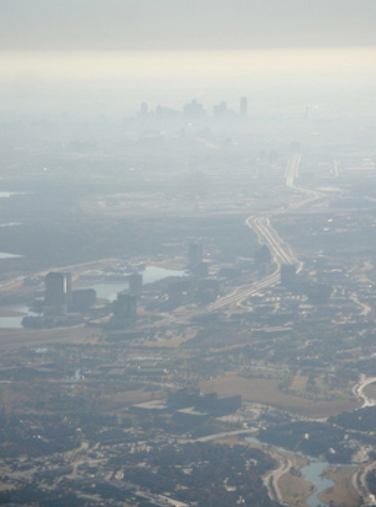Posts by jim
Two New Articles on our Citizen Science Projects
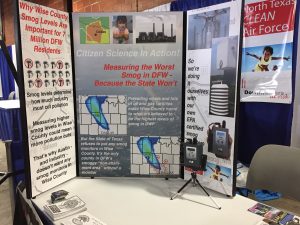 Our local “environmental paper of record” DFW GreenSource has a piece up about the DFW Air Research Consortium’s plan for a local 21st Century air monitoring network that quotes UNT Health Science Center researcher Leslie Allsopp and Downwinders’ Chair Tamera Bounds.
Our local “environmental paper of record” DFW GreenSource has a piece up about the DFW Air Research Consortium’s plan for a local 21st Century air monitoring network that quotes UNT Health Science Center researcher Leslie Allsopp and Downwinders’ Chair Tamera Bounds.
Meanwhile the Texas Observer just put up an article about Downwinders’ Wise County Ozone Project.
Both of these citizen science efforts, plus others, will be covered in each of the three “Evenings of Science and Socializing” we have coming up over the next week, beginning at 7 pm tomorrow night at the Bryan Street Tavern in Old East Dallas. The Dallas Innovation Alliance is the Co-Sponsor, and they have their own sensor pilot project in the West end to brag about. Y’all come.
Citizens Just Won a Fight Over Local Control….Now What?
 In case you missed it, last Thursday the Bluestone company pulled its permit request for a new fracking waste Injection well that was going to be sited on the western shores of Lake Arlington.
In case you missed it, last Thursday the Bluestone company pulled its permit request for a new fracking waste Injection well that was going to be sited on the western shores of Lake Arlington.
Congratulations to Liveable Arlington and everyone else who contributed to this victory. It’s always great when you can stop a bad idea in its tracks, but to stop this one, with the current Powers-That-Be, is quite remarkable.
Bluestone’s application had united a broad spectrum of allies for a Barnett Shale fight – residents, local fractivists, municipalities, and water quality groups. Fort Worth had banned such wells years prior to the passage of notorious HB40, but Bluestone acted like that ban didn’t matter. Arlington objected over its drinking water source being imperiled by the well. Bluestone shrugged its shoulders.
Here was the first challenge to the uneasy truce that settled over the state between home rule cities and Austin after HB40 took effect. And it came not from an aspiring Denton trying to protect its citizens, but from industry. And it wasn’t targeting an upstart city, but the town that industry hailed as a model of gas regulation only two years ago when HB40 passed.
Thousands of letters opposing the permit were sent in to the Railroad Commission. An army of lawyers had been hired by Forth Worth and Arlington. It became a point of contention when RRC Commissioner Ryan Sitton visited from Austin in April to attend a Stop Six community meeting and Earth Day Texas. Momentum was with the opposition as it headed into a September hearing, already postponed twice. Bluestone was, seemingly, one injection well too far: the poster boy for overreach by an industry swelled with avarice.
Which makes its sudden absence a jolt to the system. On the one hand it’s good to know that in the current political climate there’s SOMETHING industry does that goes too far, even for the Texas “bidness-friendly” regulatory establishment.
On the other, it takes the air out of the largest wave of opposition to a gas patch permit in a very long time and brings us back to the truce frozen in place in when HB40 passed. Everyone is settling back into the stifled status quo, where technology, problems, and profits can advance with time, but local regulations are forever stuck in 2015.
All that energy into opposing Bluestone, only to arrive back where we started.
Which is why now, when citizens just won a major victory, is not the time to take our foot off the gas. It’s actually the time to set the stage for a fight in Austin in 2019.
Bluestone’s permit application proves cities must have more protection than HB40 provides. It’s still a poster boy for overreach. But so are other fights. On the same day the news was announced about Bluestone’s withdrawal, the owners of a proposed concrete crushing plant that Fort Worth Eastsiders fought off last year turned back up and filed for another try. Even though city zoning prohibits the facility from the location it wants near city parks and a school.
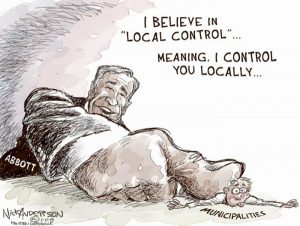 Statewide, there’s a growing backlash to Austin’s attempt to take away any and all vestiges of traditional Texas home rule local control. What started with protecting the gas industry has now swept up everything from trees to immigration and many Texas citizens, even conservative ones, are aghast at the result.
Statewide, there’s a growing backlash to Austin’s attempt to take away any and all vestiges of traditional Texas home rule local control. What started with protecting the gas industry has now swept up everything from trees to immigration and many Texas citizens, even conservative ones, are aghast at the result.
Environmentalists and fracktivists need to take advantage of this shift in the swing of the pendulum. In 2017 all of our efforts to clean-up the gas industry begin and end at the local level, where office holders must live with the results of their decisions side-by-side with their constituents. And yet HB40 makes any local advancement impossible. To get anywhere, to move off dead center, that law must be amended, or rescinded.
That is a multi-year, statewide effort that has to begin now if it’s to arrive in Austin in January 2019 with any impact.
To pull that off the movement will have to get over its aversion to coordinating regionally across city limits and be more proactive. So far, the fights in the Barnett have been city-by city, with no overarching alliances. Less coordination has meant less power. All one has to do is look at the anemic responses to HB40 in this year’s legislature to see how weak this strategy has made the movement.
But some hope could arrive in Austin in January 2019 in the form of an organized coalition of the self-interested promoting good-old fashioned local control, working with the victors of what could be a November 2018 mid-term “wave” election that might even reshape the Texas Legislature.
Who will be the architects of that strategy? Certainly not any of the larger national environmental groups, who’ve written Texas off and only want to collet money here, not spend it. It will probably have to be home grown with the assist of new groups like the Campaign to Defend Local Solutions that are linking-up threats to local control across the country.
It feels good for citizens to win one. And it would be nice if we could rest a while now and enjoy the victory, because they are so few and far between.
But sinking back into inaction only guarantees that another Bluestone will be showing up. If not in your backyard, then someone else’s. Now that we’ve established where the line in the sand is, it’s time to move the line forward.
After Only Three Months into Smog Season Another State Anti-Smog Plan Has Failed
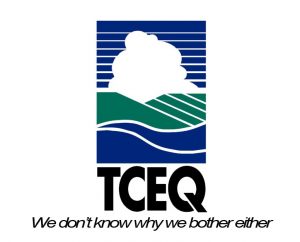 Only three months into the 2017 “ozone,” or smog, season, DFW has already recorded air pollution levels high enough to guarantee the region will remain in violation of the Clean Air Act for the 26th year in a row.
Only three months into the 2017 “ozone,” or smog, season, DFW has already recorded air pollution levels high enough to guarantee the region will remain in violation of the Clean Air Act for the 26th year in a row.
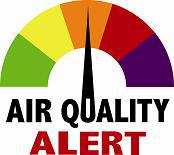
The bad news? So far, we’ve had a pretty mild kick-off to “ozone season.” Most of our worst ozone alert days have occurred on weekends on when winds were shifting.
But a couple of typical episodes in early May and June were enough to put local monitors in trouble, including the regional pacesetter at Denton Airport, to make sure that we’ll be above the current 75 parts per billion EPA standard. Only mid-way through June, Denton’s three year running average is at 78. That number can only go up as Summer wears on.
According to the the Texas Commission in Environmental Quality’s currently proposed DFW clean air plan, all monitors were supposed to be averaging 75 ppb or below.
But the Commission was never serious about that goal. For the second time since 2011, TCEQ offered up a plan that did absolutely nothing to bring smog levels down. No new controls on large sources like coal plants, cement kilns or gas compressors. No new transportation initiatives. Nothing. And nothing is what happened. And the difference between before and after the plan? Nothing. The region is still in “non-attainment” with the Clean Air Act.
Now, you might think that qualifies as a complete and utter failure as an anti-smog plan. And you’d be right. By way of common sense and the English language. But in the “Alice in Smogland” world of EPA-TCEQ agency air plan interaction and doublespeak, this State of Texas do-nothing plan has not yet failed. Bureaucratically it cannot….yet. Because it hasn’t even been approved by the EPA.
The State’s plan is still parked at Region 6 headquarters in Dallas. Why? Who knows. Pre-Trump and pre-2017 comments from EPA staff indicated it would be rejected in part or whole by now. Downwinders, other citizens groups, and elected officials were working on that assumption, trying hard to get EPA to substitute a federal plan for the state’s. The election changed all that for us, and it obviously changed the pace of decision-making at EPA.
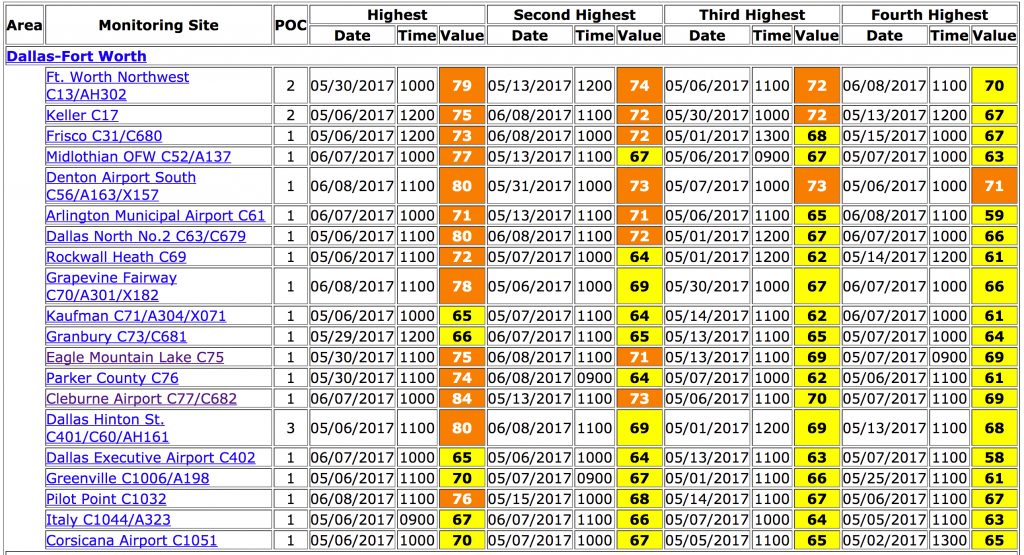
Given that it’s already failed, one would have to make a pretty good case for EPA to approve it, but again, this is a not a process always grounded in the latest facts. Now wedded to an administration that treats facts as hostile witnesses, things at EPA could get bizarre – and into court quickly.
What makes the State’s apathy worse is that EPA is letting the state get away with not providing a new plan for a current standard (even though its’ still violating it), while a new, lower standard is being (maybe) implemented over the next ….five to eight years.
But because the cut-off for violating metro areas to submit plans for the new standard was 81 ppb and DFW was at 80 last year, DFW was also given a pass by EPA to turn in a plan for the new 70 ppb standard.
So, after seeing a cycle of a plan every 3- 5 years since 1991, there will be no more anti-smog plans submitted on behalf of DFW – not for the current standard and not for the new standard. Nada. DFW won’t have to turn in a plan until well into the next decade, and then, only after it’s endangered public health by failing to meet the 70 ppb standard for three years. Of course, given our progress the last 6-7 years, it’s very possible DFW will still be violating the “old” standard.
It’s also very possible there won’t be a new 70 ppb standard. The Trump Administration has already signaled a possible roll back in EPA’s support for it. Last Tuesday, the agency gave states another year to draw non-attainment boundaries. Most had already done so with no complaints. A year from now it wouldn’t be surprising to be hearing of another delay in implementation. There’s more than one way to kill a public health standard.
Get Me To the Geeks
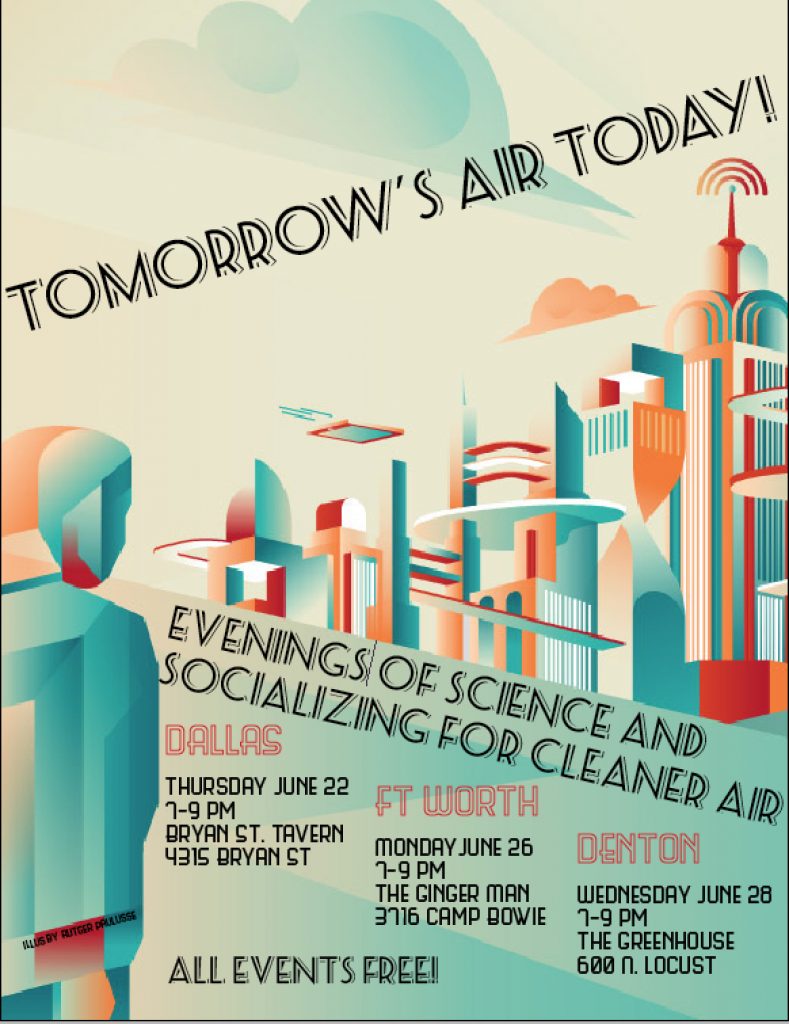
Come See How Radical The Future Really Is
3 Evenings of Exploring One of the Most Exciting Collaborations between Scientists and Citizens in the Nation while their grant is under consideration at the National Science Foundation
A consortium of N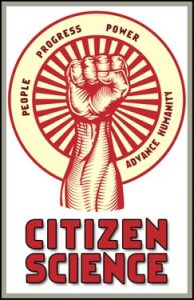 orth Texas universities, municipalities, and citizen groups, including Downwinders at Risk, is laying the foundation for a revolutionary grassroots high-tech approach to air quality monitoring that will render the current top-down system obsolete.
orth Texas universities, municipalities, and citizen groups, including Downwinders at Risk, is laying the foundation for a revolutionary grassroots high-tech approach to air quality monitoring that will render the current top-down system obsolete.
This new consortium proposes to build a dense grid of small, inexpensive air sensors that anyone can access for real-time air quality information. It’s currently in the running for a $3 million National Science Foundation grant for two local pilot projects that will do just that. It also has two other projects involving the distribution of e-sensors in DFW already in-progress. One of these is our very own Wise County Ozone Project.
It’s hard to overestimate how much of a game-changer this bottom-up approach to monitoring air pollution can become once citizens exploit its tools. Residents will be their own clean air watchdogs, asthma patients will have a huge heads-up, industrial plumes can be tracked in real time across the Metromess. Many of the ways this new effort will be most useful haven’t even been invented yet.
That’s why we’re bringing the good news of this new consortium to you in three public events.
Not only are we laying out the concept as it was presented to the National Science Foundation, but we’ll have some of the consortium’s leading researchers at each event to field your questions, and displays of some of the new generation of e-sensor air monitors being used.
 Whether you’re a asthma suffer, clean air activist, science geek, or researcher, you’ll be amazed and intrigued by the policy and public health implications of the consortium’s vision.
Whether you’re a asthma suffer, clean air activist, science geek, or researcher, you’ll be amazed and intrigued by the policy and public health implications of the consortium’s vision.
This is an opportunity to be inspired.
An unprecedented alliance is coming together in your own backyard.
Plug-in and make change happen.
Dallas
Thursday, June 22
7-9 pm
 Bryan Street Tavern
Bryan Street Tavern
4315 Bryan Street
SPECIAL GUEST:
Dr. David Lary University of Texas at Dallas
Dr. Lary is the DFW Air Research Consortium’s leading expert on environmental sensors. He’s the founding Director for Multi-Scale Intelligent Integrated Interactive Sensing Center for Space Science at UTD. He has extensive experience with both stationary sensors and use on mobile platforms, including drones.
Fort Worth 
Monday June 26th
7-9 PM
The Ginger Man
3716 Camp Bowie Blvd
SPECIAL GUEST:
Dr. David Sterling
University of North Texas
Health Science Center
Dr. Sterling has more than 30 years experience as a public health investigator. Much of his research has focused on environmental exposures in low-income communities. Dr. Sterling’s current research centers on asthma management in a school environment, and assessing how communities perceive and react to air quality issues. He’s worked extensively with the Ft. Worth League of Neighborhoods in identifying resident concerns and needs in reading and using air quality data.
Co-Sponsored by the Forth Worth League of Neighborhoods

Denton
Wednesday, June 28th
The Greenhouse
600 North Locust
Double Feature for the Host City of the
Worst Smog Monitor in the Region
Leslie Allsop MSN, MPH UNT Health Science Center
Ms. Allsop is a doctoral student at UNT’s Health Science Center and has worked for years with skeptical North Texas citizens groups to build community acceptance and effectively use the data provided by a new system of sensor air monitoring.
Dr. David Lary
University of Texas @ Dallas
The Stories of These Two Women Are 2/15ths of Why You’ll Be Inspired by Our Graduating Class Of Hell-Raisers Tomorrow Night
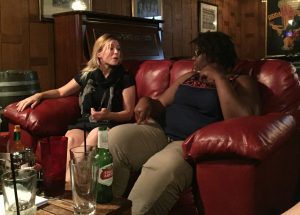
College of Constructive Hell-Raising
Class of 2017 Graduation Ceremony
8-9 pm
Gulf Coast Room, Meadows Conference Center
2900 Live Oak in Old East Dallas
Reception at Bryan Street Tavern beginning at 9:15 pm or so
Despite their similar backgrounds, upbringings, and generations of living in the same city, it took the established Dallas families of Michelle McAdam and Clarice Criss almost 100 years, and Downwinders at Risk, to get to know one another.
Even though the two women had the same proper white gloves-and-pearls Dallas grandmothers, the same bourgeois background, even the same debutante “dip,” their families didn’t socialize. Until January of this year, they had never met, or even heard of one another.
Which is really hard to believe when you see them together now. They behave more like sisters than recent acquaintances. At least sorority sisters. Which they kind of are – only from different chapters.
Michelle is an SMU coed from one of the most established and respected families in White Dallas. Clarice is the granddaughter of the founder of Dallas’ oldest Black-owned newspaper. They had pretty much the same upbringing. Only all the people at Michelle’s milestone events were white and all the ones at Clarice’s were black.
And so, after almost 100 years, what did it take to bring these mirror images of Dallas High Society together under one roof? Natural disaster? Lawsuits? Business dealings? No….A class on how to be bigger Pains-In-The-Butts to the Powers-That-Be: The College of Constructive Hell-Raising.
Michelle and Clarice have practically been inseparable since comparing notes at an informal after-class social hour in January. They attend events together. They’ve introduced their families to one another. They go shopping. They’re plotting local political strategy. All because these wayward granddaughters of their respective aristocracies decided to take a five-month class that promised to teach them to be more effective troublemakers.
Each was already primed. Michelle does front line refugee work as part of the International Rescue Committee. She notes: “Granny had plans for me to marry a nice Harvard graduate before becoming a housewife with 2.5 kids in Preston Hollow, but I was always more attracted to the misfits who weren’t afraid to forge their own paths, ask questions and challenge the status-quo.”
You should probably know “Granny” is 92 year-old Ruth Sharp Altshuler, who, as one of Dallas’ leading philanthropists has met a pope, and more than a couple of presidents, much less served on the SMU Board of Directors. She established the Women’s Foundation. She was hand-picked by Henry Wade to serve as Dallas County’s first female grand juror…to hear the indictment of Jack Ruby.
But she’s also the grandmother who told Michelle, “To whom much is given, much is required.”
“I think Clarice and I were drawn to the class for this reason. We believe we have been given the knowledge, experience, and connections to be a force for positive change in our community.”
Meanwhile Clarice is not exactly following the Deb path to success either. She’s up to her elbows in South Dallas urban agriculture and self-sufficiency projects. Her great uncle was the late William Blair Jr., founder of The Elite News, the oldest black-owned newspaper in North Texas. She admits her family is “Black Royalty.” She signed-up for the College because she wants her community to be taken more seriously by its elected representatives. “I won’t stand by and not hold people accountable.”
As to why they’ve hit it off as instant companions, Michelle says “We both have a warm, friendly, humorous nature. I can also relate to her unfiltered commentary in public! She isn’t afraid to provide her opinion and neither am I.”
To watch this just-like-me-but-still-unlikely pairing joust and joke with each other on their way to becoming BFFs is just one of the great stories emerging from the first class of the College of Constructive Hell-Raising. There’re at least 13 others – one for each student who took the leap of faith and signed-up for the first semester of organizer training ever offered to DFW residents.
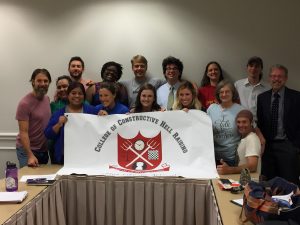 The class has been meeting since January, not only officially, but afterwards in the same informal confab at a local tavern where Michelle and Clarice began discovering their similar roots. In the process, the would-be community organizers have formed a very real sense of community with their peers. Some bonds seem so natural, it’s like they were there are along. Others are based on similar interests about issues or campaigns.
The class has been meeting since January, not only officially, but afterwards in the same informal confab at a local tavern where Michelle and Clarice began discovering their similar roots. In the process, the would-be community organizers have formed a very real sense of community with their peers. Some bonds seem so natural, it’s like they were there are along. Others are based on similar interests about issues or campaigns.
And all of them will be in the spotlight tomorrow when they graduate with their degrees in hell-raising in our first graduation ceremony. Instead of a single commencement speaker, we decided to have 15.
We’re going to close the door to the Meadows Conference Center Gulf Coast Room at 8 pm, travel forward in time 20 years and let this first class tell us how the lessons they learned at the College have impacted their lives since they graduated.
Don’t worry, we’re bringing everyone back for the reception at the Bryan Street Tavern starting a little after 9.
If you feel overwhelmed with the cacophony of bad and worse news. If you feel frustrated at the stifling of progress taking place. If you’re pessimistic about the future. We have a remedy. Come listen to these “First 15” talk about their plans and plots tomorrow night.
Don’t be afraid of the future – come meet it firsthand. We promise you’ll be inspired.
May Smog Leaves the Region in Violation of the Clean Air Act for Another Year
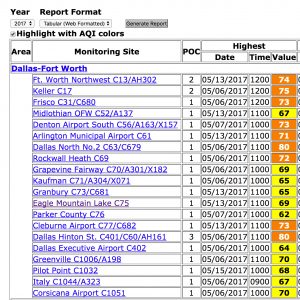 At one point in mid-May, four out of eight days were “ozone alert days.” While only one of those was critically high, the wave of higher levels was enough to push the regional average over the current 75 parts per billion (ppb) standard for 2017. It will be the 26th year in a row the DFW area has been out of compliance with the Clean Air Act’s ozone (smog) standard.
At one point in mid-May, four out of eight days were “ozone alert days.” While only one of those was critically high, the wave of higher levels was enough to push the regional average over the current 75 parts per billion (ppb) standard for 2017. It will be the 26th year in a row the DFW area has been out of compliance with the Clean Air Act’s ozone (smog) standard.
The worse news of course is that the current standard is obsolete and in the process of being lowered. The Obama EPA adopted a new 70 ppb ,and scientists advising the EPA said it really should be closer to 60-65 ppb, when many people begin noticing health effects.
To date, the Hinton Street monitor on I-35 just north of downtown Dallas and the Dallas North Site near the LBJ Freeway have the highest eight-hour averages each at 80 ppb from May 6th. Hinton saw a 1-hour reading as high as 90 ppb while North Dallas topped out at 88.
But the key to DFW’s smoggy regulatory status is the Denton monitor because it’s historically been the worst performing among the 20 North Texas monitors the state operates. It took until the May 15th episode for the wind to blow in its direction long enough to raise its numbers and to seal DFW’s ozone fate under the law for another year. It now sits at 77, barely over the current standard….but that number will rise as the summer, and ozone season progresses.
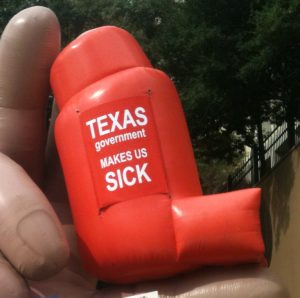
Although May saw a big wave of ozone, the region was lucky that three out of four alert days were on the weekend and shifting winds. Had the May 6th episode occurred on a Monday instead of Saturday, the numbers probably would have been significantly higher.
Forecasters have said it will be a hotter summer than last year. If so, that often portends some awful smog as well.
That’s too bad, because prospects for ANY kind of DFW clean air plan, much less a more effective one went down the tubes with the election results. There is no effective oversight by the EPA. There are no new air pollution controls being required of any major sources. We’re now completely dependent on the coattails of existing regulations, the marketplace, and whatever we can build from scratch at the local level to get us out of our dirty air rut.
Meanwhile, every so slowly, the Trump Administration is signaling it would really like to roll back that new 70 ppb smog standard to the old 75 one. It recently asked for, and got, a delay in a lawsuit filed by industry to challenge EPA’s decision. Almost every commentator believes this is in anticipation of the Trump EPA giving up the fight. But while that might be a short term victory for polluters, the law behind establishing these ozone standards makes it less likely to be a permanent one.
Nevertheless, these are more reasons for us to be about the business of becoming more self-reliant in addressing DFW’s chronic air pollution problems.
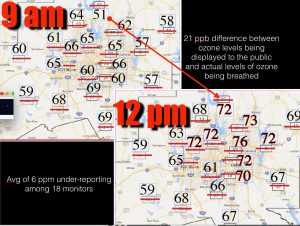
As always, every time there’s an ozone alert day, we’ll be tracking the smog on our FB site, at least as best we can when there’s a two-and-a-half-hour lag time between sample and posting of the sample on the state’s handful of monitors.
And …as you might have noticed, every time there’s a DFW ozone alert, you’ll also get a nudge from Downwinders at Risk to contribute some money to the cause of cleaner air.
Some of you may have felt assaulted by these appeals when things were getting smoggy and then smoggier in Mid-May. We apologize for the inconvenience, but not for the appeal. Ozone Alert Days are the most obvious signs of a failed state policy to provide safe and legal air to 7 million people. If we’re going to continue to be effective on your behalf, we need all the help we can get. Thanks.

Transformational National Science Foundation Grant for 21st-Century Air Monitoring Gets a Call Back
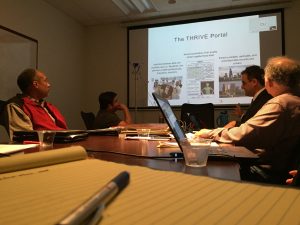 In a milestone for the local consortium Downwinders At Risk is working with to bring DFW air quality monitoring into the high-tech era, its $3 million request to the National Science Foundation for funding two pilot projects got a call-back last week.
In a milestone for the local consortium Downwinders At Risk is working with to bring DFW air quality monitoring into the high-tech era, its $3 million request to the National Science Foundation for funding two pilot projects got a call-back last week.
Led by University of Texas at Dallas high tech guru Dr. David Lary, the group includes scientists and researchers from the University of North Texas and UNT’s Health Science Center, Texas Christian University, the cities of Dallas, Fort Worth Plano and Richardson, the Fort Worth Independent School System, the Dallas County Community College District, the Fort Worth League of Neighborhoods, Livable Arlington, Mansfield Gas Well Awareness, and Downwinders at Risk.
There were said to be over 200 applicants applying for the NSF’s “Smart and Connected Cities” grant when the deadline passed about a month and a half ago. The NSF isn’t revealing how many of them got a follow-up “Virtual Site Tour” of the proposal, but the number isn’t believed to be very large. Rumor has it that one of the main competitors to the DFW proposal is Argonne National Laboratories, a 70-year old gigantic research industrial complex born out the Manhattan Project.
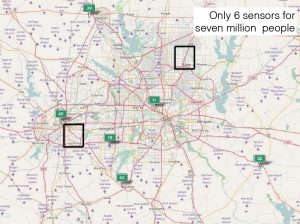 That a group that wasn’t even in business a year ago is now in the running with such a Colossus in a very competitive nationwide talent contest for valuable and scarce research dollars is pretty remarkable on its own. What makes it even more remarkable is that staff at the NSF itself actively discouraged the DFW project from even applying, because they didn’t think the proposal could compete with the scientific heavies already in the race.
That a group that wasn’t even in business a year ago is now in the running with such a Colossus in a very competitive nationwide talent contest for valuable and scarce research dollars is pretty remarkable on its own. What makes it even more remarkable is that staff at the NSF itself actively discouraged the DFW project from even applying, because they didn’t think the proposal could compete with the scientific heavies already in the race.
But what the NSF staff underestimated was how much the DFW project challenges and changes the status quo from the bottom up. It’s hard to imagine a proposal that has the potential to deliver more benefits to more people. 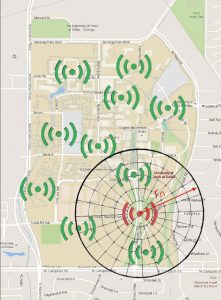
At the heart of the vision for the DFW grant proposal is the idea of an independent network of hundreds, then thousand of small e-sensors placed in a thought-out grid across the entire urban core of the Metromess. These sensors would be located every kilometer or even half-kilometer, block by block, down major thoroughfares, by schools and parks and daycare centers, by facilities that pollute.
So instead of relying on a handful of clunky large official EPA/TCEQ monitors scattered over an area the size of a couple of New England states, you know have data from just outside your own door.
Moreover these sensors would be able to deliver information about air quality in real time to an app on your phone or computer. Contrast this with the two-and-a-half hour wait between sampling and result you see on the official monitor websites now.
But wait, there’s more. As part of the app, you’re made aware of local conditions via an avatar or virtual human, who you can design yourself from a number of attributes. It will present you a list of health symptoms the poor air quality might trigger. But this avatar is also interactive through the network “portal.” You can upload your own symptoms when you’re having a bad air day. The software will look for correlations – wind direction and speed, concentrations of pollutants and allergens in the air, etc. and alert you when days are shaping up to be like the ones that give you trouble.
In the same way many of us now check the weather forecasts, pollen counts, and ozone alerts to know if we need to take extra care with our lungs, you can use this network and software to fine tune that investigation to a degree never before possible.
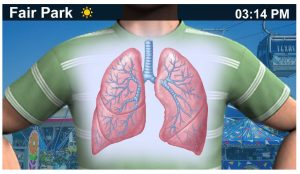 Want to be a neighborhood air pollution watch cop? Use the software to track down hotspots you didn’t even know existed, or enforce the permits issued to local facilities. The network of sensors allows you to track plumes in real time as they cross county and city boundaries.
Want to be a neighborhood air pollution watch cop? Use the software to track down hotspots you didn’t even know existed, or enforce the permits issued to local facilities. The network of sensors allows you to track plumes in real time as they cross county and city boundaries.
This is all administered by an independent group of researchers, colleges, scientists, municipalities, and public health specialists, not the State of Texas or EPA. And it’s all made possible by the same leaps in technology behind smart phones, smart cars, and even smart refrigerators: the ability to cram larger and larger tech capacities into smaller microchips and sell them for less money.
While the aim is to grow a huge network of sensors, the submitted NSF grant proposal calls for establishing two separate smaller pilot project grids of 40 sensors a piece – one grid in Southeast Fort Worth and one in Central Plano.
As the proposal explained, the differences in these two communities represent different ways to use the sensor network.
SE Fort Worth is a predominantly African-American and Latino neighborhood with documented high childhood asthma rates, high absentee rates in its schools, and for much of the year lies downwind from the Midlothian cement plants.
There the network can demonstrate how it can become a household health consulting tool, as well as empower neighborhood groups to address micro and macro-level air quality problems. Downwinders at Risk’s role in SE Fort Worth is yoking the high tech sensor network with traditional community organizing. In effect, we’re creating a new citizens tool for cleaner air and a brand new guide on to how to use it to get results.
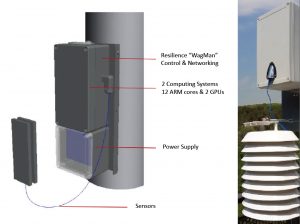 In Plano, city officials want to use the sensor network to help traffic flow and minimize vehicular air pollution. Smart technology is already being installed in the city’s infrastructure, so it’s not a huge leap to imagine installing their 40 sensors on a major roadway for 40 blocks in a row to see how traffic light timing and other variables can be adjusted to minimize internal combustion transportation pollution.
In Plano, city officials want to use the sensor network to help traffic flow and minimize vehicular air pollution. Smart technology is already being installed in the city’s infrastructure, so it’s not a huge leap to imagine installing their 40 sensors on a major roadway for 40 blocks in a row to see how traffic light timing and other variables can be adjusted to minimize internal combustion transportation pollution.
When you begin to realize that the system can not only report conditions, but learn from them and apply that learning to being able to guide not only your own personal health, but the public health policy for millions, you realize how transformational this technology can become. It has the potential to be the most important tool in fighting for cleaner air that we’ve ever seen – because it works from the bottom up and puts the power to change things in the hands of individuals instead of agencies.
We don’t always have to fight the bad guys head on – we can go around them. We can replace them. That’s what makes this network so sublimely subversive. It just leap frogs over an obsolete, regressive status quo.
We should know by the end of next month whether the participants in last week’s call were persuasive enough to convince the NSF to fund the DFW project. Regardless of that decision, the same consortium of colleges, cities and citizens groups is committed to building-out their own 21st-Century air quality monitoring network.
Today is the Third Ozone Action Day In a Row: the State really wants you to contribute to us
This year, every time
the State of Texas
declares an
“Ozone Action Day”
We want you
to take action
by donating as little
as $5 bucks to Downwinders
_______________________________________
MONDAY, MAY 15th – The last three days in a row, and the last 4 out of 8 days have been Ozone Action Days in DFW.
Yesterday’s wind speed kept things to a duller roar, but the smog was just bad enough to push up our regional average and make sure that we’ll spend another year in violation of the Clean Air Act, no matter what else happens this summer.
That’s right, it’s only May but the smog on Sunday was bad enough for long enough in Denton yesterday to make sure the 3-year average went over the current 75 ppb standard to 77.
And we still have June, July, August and September to go.
Downwinders at Risk has been working for cleaner air here in DFW since 1994. No group has been more successful in winning pollution cuts from local industry. But these victories don’t come easy or cheap.
We’re entirely local. We depend on local donations to support the only full-time staff devoted to improving North Texas air quality.
We started this new fundraising campaign because Ozone Action Days are the most obvious signs of failure of the state’s do-nothing approach to DFW’s chronic smog problem.
When smog gets bad now, there’s something you can do that’s guaranteed to make them mad in Austin: making sure Downwinders sticks around and continues to advocate for your lungs.
We appreciate your support and promise we’ll keep fighting hard for safe and cleaner air.
To make the Powers That Be angry, please donate to help Downwinders become an even more effective advocate for safe and legal air.
It’s a Bad Air Day. Fight back with a donation to the only citizen’s group that’s fighting DFW smog year round
 The Texas Commission on Environmental Health has issued an ozone alert for today, Saturday May 13th. It issued one for last Saturday as well. It has issued one for tomorrow too.
The Texas Commission on Environmental Health has issued an ozone alert for today, Saturday May 13th. It issued one for last Saturday as well. It has issued one for tomorrow too.
We’re not going to tell you to ride a bike or share a ride. That’s great stuff to do, but we need deep, long-term, systematic change to breathe safe and legal air.
One new control device on a local cement kiln, coal plant or compressor can reduce the equivalent pollution of thousands and thousands of vehicles the moment it’s turned on. But the political process to implement those controls remains hostage to industry and forces hostile to any air quality regulations, no matter how beneficial to public health.
In 2017, Downwinders at Risk is still the only group devoted to seeking that deep, long-term, systematic change in DFW air quality…24/7 365 days a year. After 23 years, we’re still here, still 100% local, and still committed to our mission, funding the only full-time staff working to get safe and legal air for you.
You can’t vote against anyone today. You can’t go to a hearing and testify. But if you’re mad about or just tired of having to still worry about the air you’re breathing, you can give a little bit of money to the local clean air group every time there’s a bad air day. Like today….
Downwinders Spotlighted as part of Goldman Prize Celebration
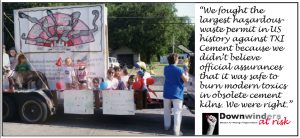 Economics and Physics has the Nobel. Journalism has the Pulitzer. Environmentalists have the Goldman.
Economics and Physics has the Nobel. Journalism has the Pulitzer. Environmentalists have the Goldman.
The Goldman Prize is the world’s largest award honoring grassroots environmental activists. It’s awarded to six activists every year – one on each continent. Winners are selected by an international jury who receive confidential nominations submitted by a worldwide network of environmental organizations and individuals. Since the it was established in 1989, a total of $15.9 million has been awarded to 157 honorees from more than 79 countries.
Last month the 2017 Goldman Prize winners were announced and two of the recipients echo local fights of our own, briefly turning the spotlight on Downwinders’ beginnings as a group fighting the burning of hazardous waste in the local Midlothian cement kilns.
Uroš Macerl, an organic farmer from Slovenia, successfully stopped a 130-year old LaFarge cement kiln from co-incinerating pet coke with hazardous industrial waste by rallying legal support from fellow Eko Krog activists and leveraging his status as the only citizen allowed to challenge the plant’s permits.
As part of the celebration of his winning, global anti-incineration group GAIA is hosting a page featuring other cement kiln warriors and of course no such page would be complete without a mention of Downwinders. Answering the question posed by GAIA of “Why We fought?” the memorial features the Downwidners float in the 1995 Duncanville Fourth of July Parade with the statement the “We fought the largest hazardous waste permit in US history against TXI cement because we didn’t believe official assurances that it was safe to burn modern toxics in obsolete cement kilns. We were right.”
The North American Goldman winner was Mark Lopez who was recognized for his role in closing down, and then getting a clean-up of the Exide lead smelter on Los Angeles’ East Side. That would be the same Exide corporation that operated an outlaw lead smelter in Frisco until Downwinders and its affiliate Frisco Unleaded teamed up to close it down in only nine months back in 2012.
Downwinders salutes all the Goldman Prize winners but wonders if anyone on either coast will take note of what this “little group that could” has done here in the belly of the beast over the last two decades? If you agree we’re at least worth the consideration, won’t you please throw some money into the hat. We’ve still got Giants to slay.

